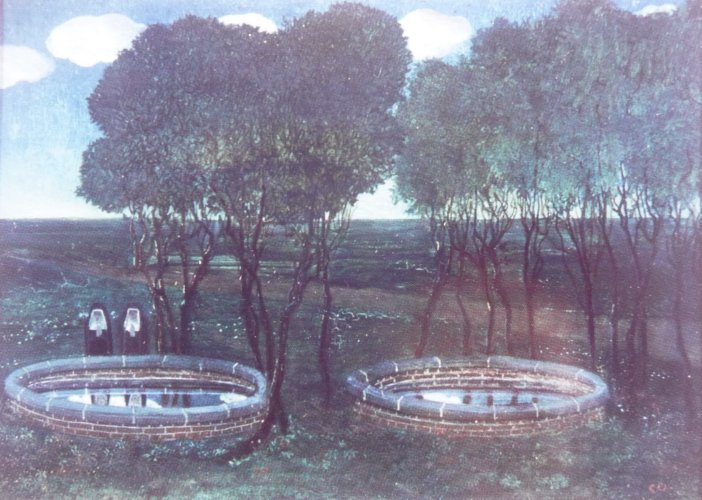Description:
Charles Doudelet (1861-1938) was born in Lille, France. He was a Flemish painter. His artistic interests were varied. He studied music and sculpture. Then he made bronze casts. He was involved in photography. He worked for Professor Emile Van Ermengem, a bacteriologist, for whom he drew pictures of microscope preparations.** Finally, he devoted himself to graphics. He studied under Constantina Meunier. He created illustrations for books, among other things. Doudelet was fascinated by Maeterlinck’s theatrical literary creativity. At his request, in 1896, he illustrated the collection of songs “Douze Chansons”.*** Over time, he also painted with watercolors and oil paints. He was inspired primarily by Quattrocento painters.****
Description of the painting:
The painting “Piety” was purchased by Edward Aleksander Raczyński in Paris in 1900 at the Siegfried Bing collection auction. It combines Art Nouveau form with a composition reminiscent of medieval miniatures.*****
On this small painting, the artist captured two twin water reservoirs. They are walled. They have an oval shape. They are surrounded by slender silhouettes of tall trees. The only thing that stands out against the flat surroundings, covered with low-growing and diverse vegetation. Across the field of the painting, a path leading through the meadows is painted. Only after a while, among the greenery, we notice the scaffold of two figures. They stand by the first basin. These are two nuns dressed in black habits. They are immersed in prayer. Their hands are folded. Their reflection was fixed additionally in the mirror of water. Attention is drawn to the multiplied dualism of the composition of the representation. Two water reservoirs. Two groups of trees. Two nuns whose presence in the work is doubled through their reflection in the water. Two different worlds. The water painted by Doudelet becomes a kind of mirror of the spiritual world. In its reflection, the silhouettes of the women are fixed against the sky vault covered with clouds. Unnoticed often during everyday, multi-hour prayers, with lowered eyes, in contemplation, often in closed rooms. “Piety” shows the beauty and richness of the target world to which the prayers are directed.
The symbolism of the well in folk beliefs is very elaborate. It becomes a place of connection between the underworld and everyday reality.****** In practical terms, the well is primarily a place to obtain water. This, on the one hand, can be life-giving, on the other – it becomes one of the causes of death. Hence, water reservoirs are often presented in the company of guardians guarding access to them. It is significant to note the connotation of the meaning of the well depending on the cultural circle in which they are inserted. “In magical tales, contact with the well and its inhabitants for an ordinary mortal ends happily, in legends – positively or negatively, while in tales most often tragically”.******** Wells are usually located outside the city, on hills. Contact with them is synonymous with contact with supernatural forces.
Wells connect the natural world with the underworld, but in Doudelet’s view, the opposite is happening. The mirrors of water placed in artificially created reservoirs reflect the sky, i.e. the spiritual world, by many – living only in the shadow of the world of ideas and values – invisible. “Piety” shows how the well is also a place of reflection of the spiritual world and its beauty.


